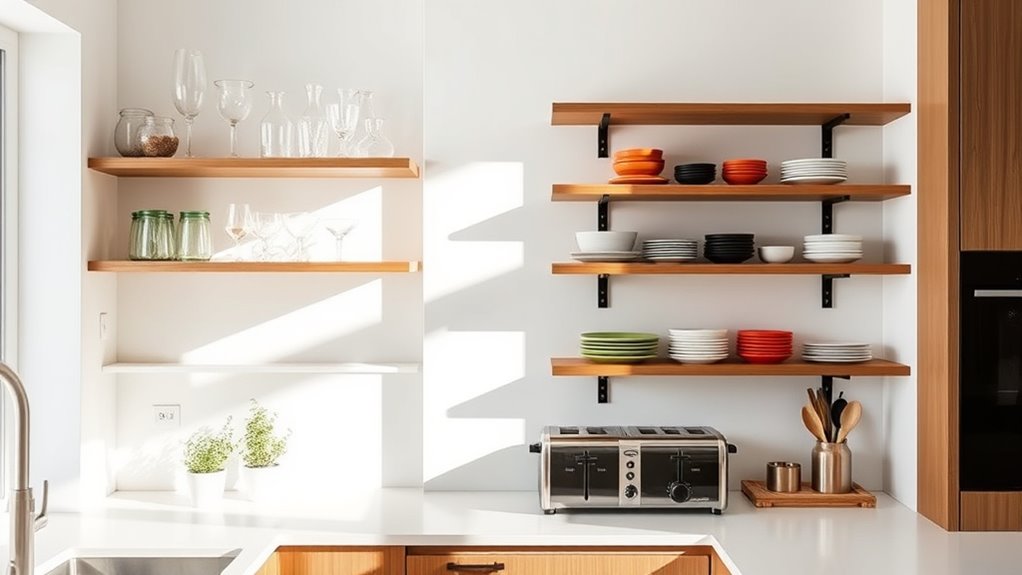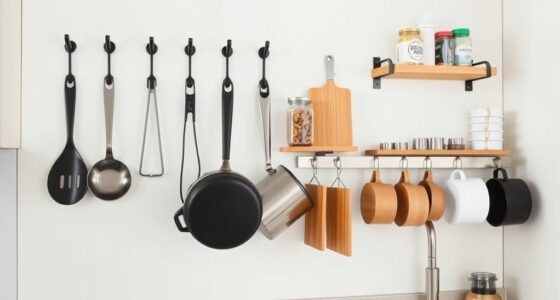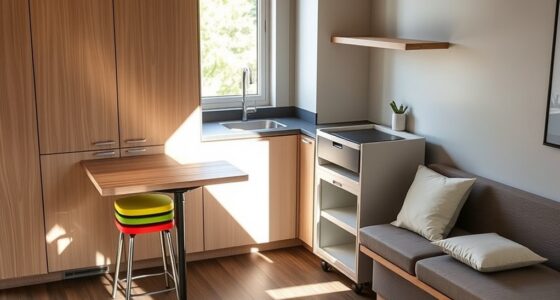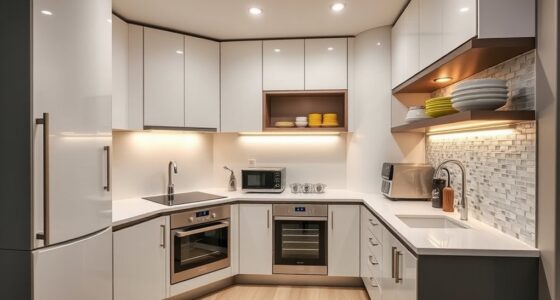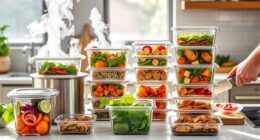Open shelving in small kitchens can make your space feel larger and more personalized, offering easy access and a stylish display area. However, it can also lead to clutter if you’re not careful, requiring regular upkeep to keep everything tidy. To succeed, keep shelves simple and only display attractive, functional items. If you stay intentional and organized, open shelving can be both practical and visually appealing—exploring these tips further can help you master the look.
Key Takeaways
- Open shelving can make small kitchens appear larger and more open but requires careful organization to prevent clutter.
- Regular maintenance, including decluttering and using decorative containers, helps maintain a tidy and attractive open shelf display.
- Limit displayed items to functional and attractive pieces to create a balanced, cohesive look while avoiding visual overload.
- Combining open shelves with closed cabinets offers flexibility, hiding less appealing items and reducing clutter.
- Thoughtful curation and styling of open shelves enhance both practicality and aesthetic appeal in small kitchen spaces.
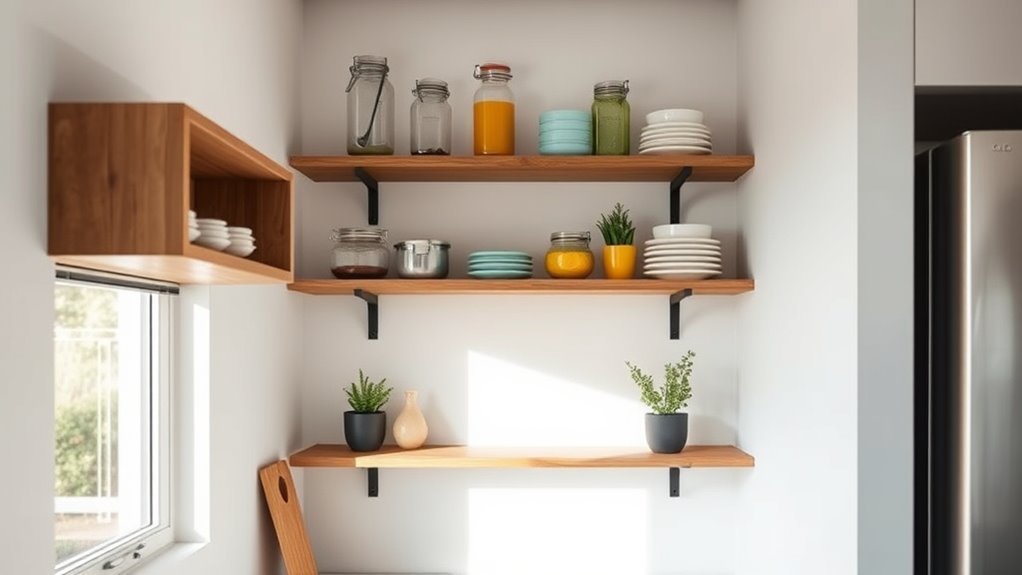
Open shelving can be a game-changer for small kitchens, making the space feel more open and accessible. Instead of traditional cabinets that can make a room feel cramped, open shelves give you the freedom to showcase your favorite dishes, glassware, or decorative items. This setup isn’t just practical; it’s an opportunity to add a personal touch to your kitchen’s aesthetic. When you carefully curate what you display, open shelving becomes a decorative display that enhances your overall design. You can mix and match colorful plates, vintage mugs, or stylish jars to create visual interest. But with this opportunity comes the challenge of clutter management. If you’re not mindful, open shelves can quickly turn into catch-alls for miscellaneous items, making your kitchen look messy and chaotic instead of charming.
Open shelving enhances small kitchens, but requires careful curation to avoid clutter and maintain visual appeal.
The key to successful open shelving is intentionality. You want to keep things tidy and intentional, so your shelves remain appealing rather than overwhelming. Regularly assess what’s on display and remove items that don’t belong or aren’t used often. Use decorative containers or baskets to group smaller items and keep the shelves looking organized. This not only declutters but also adds a layer of sophistication to your display. When you maintain a balance between practicality and aesthetics, open shelving becomes a functional design feature rather than a clutter magnet. It’s about striking that sweet spot where your shelves look curated and welcoming, not chaotic.
Another tip for managing clutter is to limit what you store on your open shelves. Only keep items that are attractive and functional—think beautiful bowls, stylish mugs, or attractive storage jars. Reserve the rest for cabinets or drawers. This way, your open shelves serve as a visual showcase rather than a catch-all for everything. When you’re selective, you can create a cohesive look that elevates your small kitchen’s style. Plus, it’s easier to keep things tidy when you don’t have to sift through clutter every time you need something. Remember, less is more, especially in a small space. By maintaining a clean, curated display, you make your kitchen feel larger, more inviting, and better organized.
Additionally, understanding that dream symbolism can influence how you interpret and organize your space might inspire you to arrange your open shelves in meaningful ways, blending practicality with personal or spiritual significance.
Frequently Asked Questions
How Do Open Shelves Affect Kitchen Cleanliness and Dust Accumulation?
Open shelves can make your kitchen look stylish, but they also invite dust buildup and pose cleaning challenges. Dust easily settles on the surfaces, so you’ll need to clean them more often to keep everything tidy. Regular dusting and wiping are essential to prevent dirt from accumulating. While open shelves are convenient for access, staying on top of cleaning guarantees your kitchen stays fresh and hygienic.
What Are the Best Materials for Open Shelving in Small Kitchens?
Imagine your kitchen as a canvas — what materials will make it both functional and beautiful? For open shelving, choose materials with high durability, like stainless steel or solid wood, that withstand daily wear. They also offer aesthetic appeal, adding warmth or sleekness to your space. These materials resist moisture and scratches, keeping your shelves looking fresh longer. Select wisely to create a stylish, durable, and practical centerpiece for your small kitchen.
How Can I Prevent Clutter on Open Kitchen Shelves?
To prevent clutter on open kitchen shelves, focus on smart decor organization and shelf styling. Keep only essential items on display, and use uniform containers or baskets for smaller items to maintain a tidy look. Arrange items thoughtfully, grouping similar items together, and leave some space between them. Regularly declutter and rotate decor to keep shelves looking fresh and organized, making your small kitchen feel more spacious and inviting.
Are There Safety Concerns With Open Shelving in Busy Kitchens?
In busy kitchens, safety concerns with open shelving mainly involve falling objects or clutter. To prevent accidents, you should focus on proper storage organization, ensuring heavier items are stored securely on lower shelves. Use safety precautions like securing shelves to the wall and avoiding overloading. Regularly check for stability and clean up spills promptly. This way, open shelving remains functional without compromising safety.
How Do Open Shelves Impact the Overall Kitchen Lighting and Ambiance?
Open shelves brighten your kitchen by reflecting natural light and creating an inviting ambiance. They enhance the overall lighting with an ambient glow, making the space feel larger and more open. With carefully arranged items, you can maximize natural brightness while avoiding clutter. Open shelving invites visual flow, draws attention to your decorative pieces, and fosters a warm, welcoming atmosphere, transforming your kitchen into a lively, well-lit hub for cooking and gathering.
Conclusion
So, go ahead and embrace open shelving—because nothing says “organized chaos” quite like a constant battle with dust and misplaced mugs. After all, who doesn’t love the thrill of rummaging through clutter just to find that one elusive spice jar? In the end, open shelves are perfect if you enjoy living on the edge, armed with a duster and a sense of humor. Happy decorating, brave kitchen conqueror!
